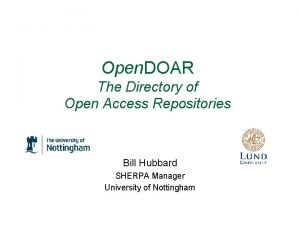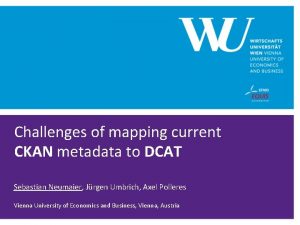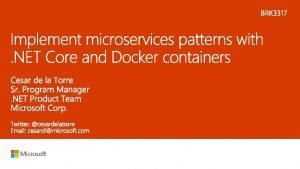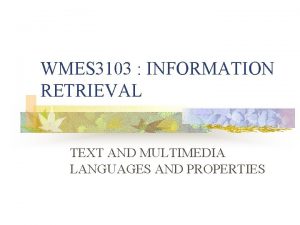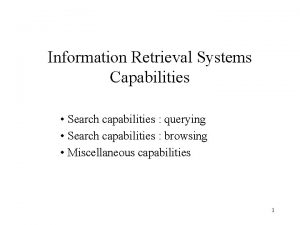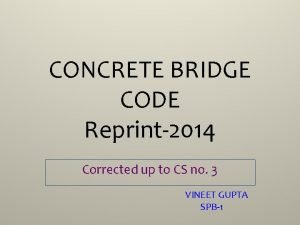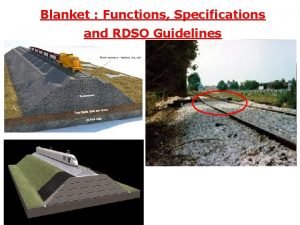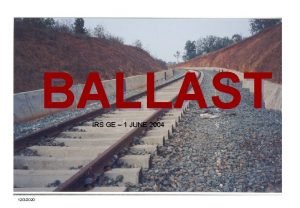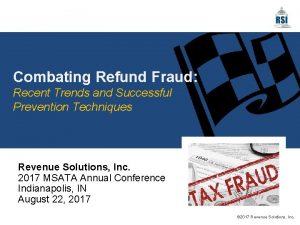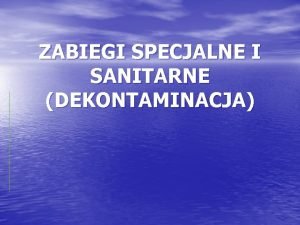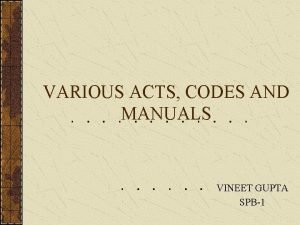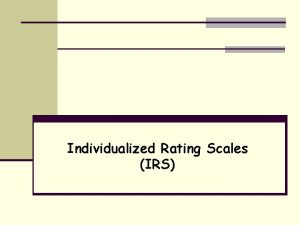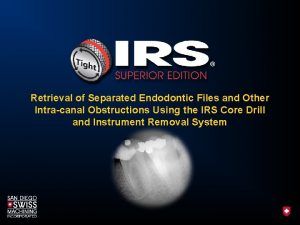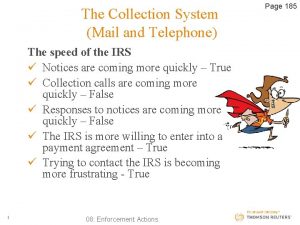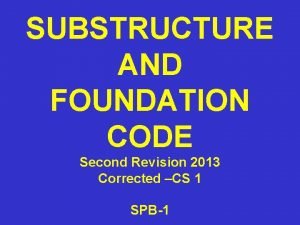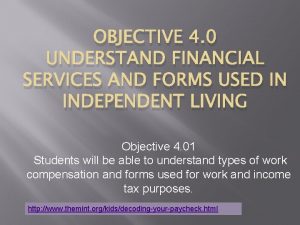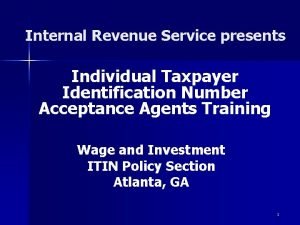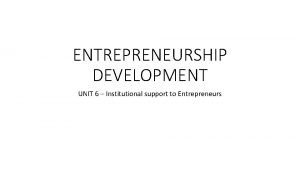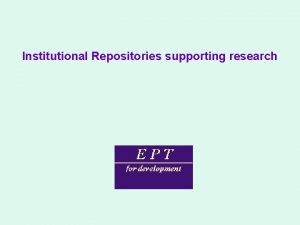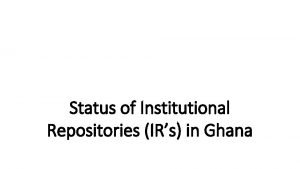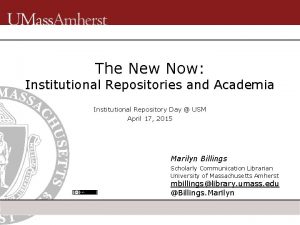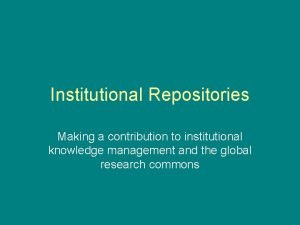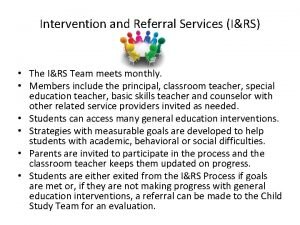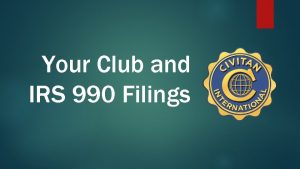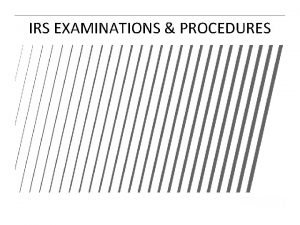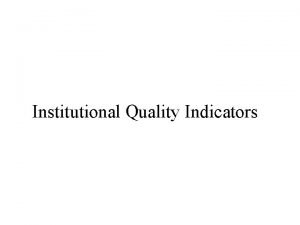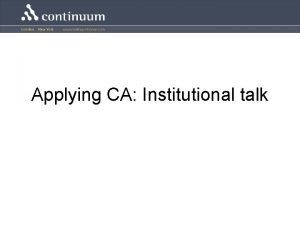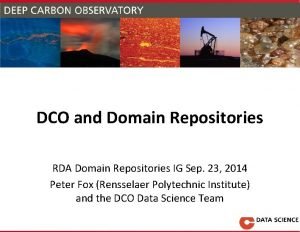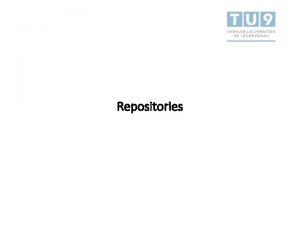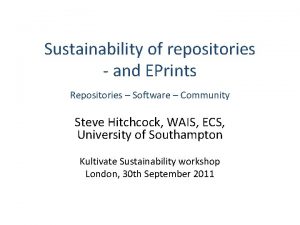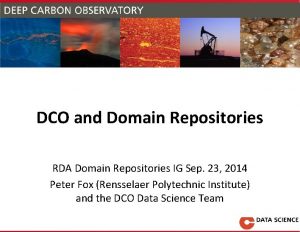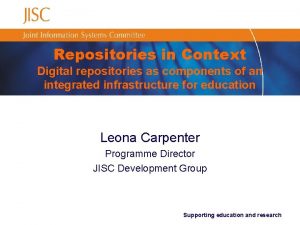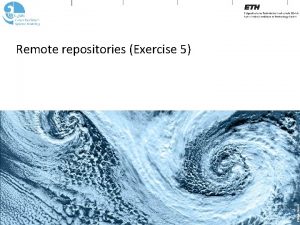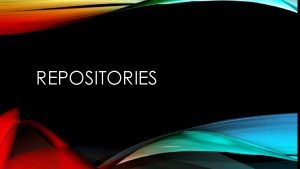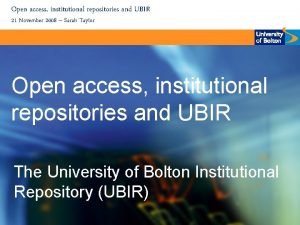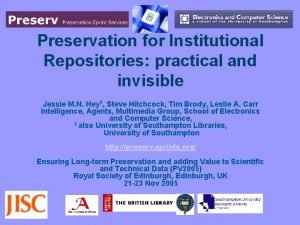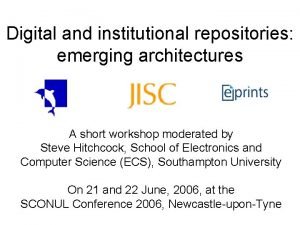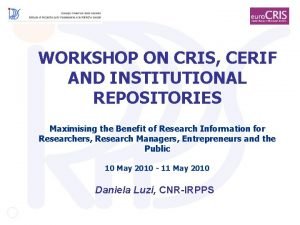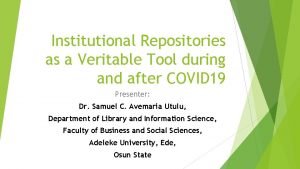What and the Why of Institutional repositories IRs
































![Content enrichment: A strategy • Initial efforts [Submission by Library staff] – Publications hosted Content enrichment: A strategy • Initial efforts [Submission by Library staff] – Publications hosted](https://slidetodoc.com/presentation_image/43646116af9e83f5002bda1e14376881/image-33.jpg)




- Slides: 37

What and the Why of Institutional repositories (IR’s) Susan Veldsman e. IFL Content Manager Ghana, 12 -13 June 2007

Agenda • • What is an Institutional Repository? Benefits of Institutional Repositories Software options Features and functionality Implementation Challenges Conclusion

What is an Institutional Repository (IR)? “An institutional repository is a digital archive of the intellectual product created by the faculty, research staff, and students of an institution and accessible to end users both within and outside of the institution, with few if any barriers to access. ” -The case for institutional repositories: A SPARC position paper. Release 1. 0, 2002. http: //www. arl. org/sparc • “University-based institutional repository is a set of services that a university offers to the members of its community for the management and dissemination of digital materials created by the institution and its community members” -Clifford A. Lynch. Institutional repositories: Essential infrastructure for scholarship in the digital age. ARL Biomonthly Report 226, February 2003. http: //www. arl. org/newsltr/226/ir. html

What is an Institutional Repository (IR)? • What does an IR do? - Provide interface for online submission of research publications (intranet) - Provide online (open) access to the content (metadata and full pub) - Share metadata with other IRs • What does an IR system consist of? - Hardware, software, staff for managing the IR and content

What is an Institutional repository (IR)? • Usage of IRs – Long term preservation, organization, access and distribution of research content – Improved scholarly communication through inter-operable, open access, IRs – Improved research knowledge management

Who can set up an IR? • Any institution interested in improved preservation, organization and dissemination of its intellectual assets – universities, public and private R&D laboratories, business establishments, etc. • Current focus – institutions of higher education – major stake-holders in scholarly communication (focus of this presentation)

Content • Example Criteria* - Scholarly: research/ teaching oriented - Produced by an institution’s research community - Non-ephemeral: work in complete form, ready for dissemination - Perpetual license: author grants the right to the institution to preserve and distribute the work via the repository * SPARC Institutional Repository Checklist & Resource Guide. Release 1. 0, Nov 2002. http: //www. arl. org/sparc/IR/IR_Guide. html

Content Examples • Published material – Ex. : Journal papers (post-prints), book chapters, conference papers • Unpublished/ gray material – Ex. : Pre-prints, working papers, theses and dissertations, technical reports, progress/ status reports, committee reports, etc. • Supporting material – Ex. : Data sets, models, simulations

Types of Repositories • Discipline-based, global repositories – Ar. Xiv, Re. Pec, Cog. Prints • Document-type-based – Global: NCSTRL, NDLTD – National: Theses (Ex. Vidyanidhi, Univ Mysore) – Institutional: Theses (Ex. IIT, Mumbai) – Departmental: Tech reports (CS) • Institutional e-print archives/ repositories – recent development/ rapid growth

Impetus for emergence of IRs • • Growing volume of born-digital research material Various publication types and formats Represent organization’s intellectual output Innovative Internet use by scholars to disseminate their research findings Dropping storage & computer costs Researchers’ interest in digital publishing Discipline archives Initiatives for alternate, open access publishing – SPARC, PLOS, BOAI, etc. • Digital library technologies – metadata standards, interoperability protocols, preservation strategies, digital library and repository software • Key Challenges: How do we support archiving and dissemination needs? Who will undertake stewardship of this digital material?

Benefits to Institutions • Organizational support for faculty seeking innovative approaches to research dissemination • Demonstrate the quality, and scientific, social and economic relevance of an institution's research • Increase the institution’s visibility, status and public value • Improved research knowledge management

Benefits to Researchers • • • • Establish priority for research findings Wider access and visibility Improved impact Share unpublished ideas and know-how’s Rapid communication of research Long-term preservation of research papers Complement and supplement journal publishing Promote collaborative research Attract research funding Establish priority for research findings Easy access to faculty papers by students Fulfill social function – public access and visibility Facilitate knowledge sharing and ‘re-use’

Impact on Scholarly Communication • Support reformation of scholarly communication system – ‘Self-archive’ research publications* – Provide ‘open access’ to the archive • Inter-operable institutional repositories – Inter-operability protocols for metadata harvesting (OAI-PMH) – Central, cross-archive, search services – Global access to research literature

Opportunity for Libraries • IR’s provide excellent opportunity to libraries – to reassert their importance in organizations, in the face of declining user dependence on libraries for information access • Get closer to and contribute at the point of information generation and distribution in scholarly information life-cycle

IR Software • Key component of an IR is the repository management software • Several software now available under open source license • Comply with OAI metadata harvesting protocol • Released and publicly available

Repository Software Systems Key Features and Functionality Specific features and functionality varies across different systems

Key Features and Functionality • Registration of institutional users (authors) – For document submission and other privileged use – User authentication – Profile set up • Document submission – Authentication – Assign Metadata – Upload Document – Grant license • Approval/ moderation – Submission approval (metadata, format, affiliation, etc. ) – Content approval (peer review)

Key Features and Functionality • Archiving – Date stamping – Unique/persistent identifier assignment – Preservation support – Indexing and storage • Dissemination – Search, browse – OAI registration and compliance (metadata exposure) – Rights management • Administration – Administer communities, collections, users, groups – Document formats, metadata – Licenses, submission policies – Preservation

Content Producers (Institutional) Institutional Research Output Tech Report Conf. Paper Journal article, etc. Mediated submission by Library staff Deposit (Metadata + Full Pub) IR Software Digital Repository (Metadata + Digital Object) Access & Dissemination Local intranet access (on institutional intranet) Metadata OAI-PMH Cross-archive search Service Remote Internet Access

Accessing content through a OAI Cross-Archive search service provider (eprints@iisc registered at OAI. Metadata harvested by ARC service provider)

OAISTER

Open. Doar

Arc…

Google….

Implementing Institutional Repositories

Implementation • Resource requirements – Infrastructure • Repository server (P 4, 512 MB/1 GB RAM, enough storage, Linux OS) • Support for fault tolerant operation • Network bandwidth – Human resources • Installation and configuration • Content management, promotion & advocacy • Administration and maintenance

Implementation • Management commitment and long term funding support • Processes – Development of policies: • Document types and formats • Submission and approval policy & procedures • Preservation policy • Author permissions/ license terms • Rights management – Development of metadata and cataloguing specifications, quality standards – Selection, installation and configuration of repository software system

Implementation • Processes – Publishers’ copyright/ archive policy* compliance – Encouraging faculty participation • Content submission and usage • Addressing faculty concerns – IPR, quality, workload, undermine tried/tested practices – Dissemination and service provision – Administration and maintenance * Project Ro. MEO (Rights MEtadata for Open archiving) http: //www. lboro. ac. uk/departments/ls/disresearch/romeo/in dex. html

Costs – Start-up costs low • hardware • software (repository software free) • installation • policies and procedures – Medium-term costs higher • advocacy – getting content • support • mediated submission – Ongoing costs significant • metadata creation / enhancement • preservation

Implementation • Location: Various organizational units: Library, IT/Computing Centre, Archives/ Records Management Centre • Collaborative effort of: – Librarians – IT specialists – Faculty – Administration

Key Challenges

Key Challenges • Attracting content to the repository – Managing cultural change – Selling the concept to researchers: complementary & supplementary role of the institutional repository – Libraries can play proactive role • Peer review/ quality control – Defining and managing content quality • Community-based moderation/ approval process? • Tie-up with open access journals? • ‘Low-barrier-to-submission’ policy?
![Content enrichment A strategy Initial efforts Submission by Library staff Publications hosted Content enrichment: A strategy • Initial efforts [Submission by Library staff] – Publications hosted](https://slidetodoc.com/presentation_image/43646116af9e83f5002bda1e14376881/image-33.jpg)
Content enrichment: A strategy • Initial efforts [Submission by Library staff] – Publications hosted on faculty home pages – Publications archived in discipline archives – Publications in repositories like Citeseer, NCSTRL – Publications in open access journals, institutional journal, journals permitting post-print archiving • Ongoing – Self archiving by faculty – Scanning e-journals and databases, and submission by library staff – compliance with publisher archive policy • Metadata only submission, if full text archiving not possible

Key Challenges • Long term preservation approaches – Ex. : DSpace: Bit preservation, format preservation • Management of digital rights – ‘Creative Commons’ (www. creativecommons. org) • Persistent identifiers – Ex. : CNRI’s ‘Handle’ system (www. handle. net) • Development of aggregated repository infrastructure – Based on inter-operable institutional repositories – Consortia, regional, national, discipline? – Ex. : FAIR, UK and DARE, Netherlands • How to achieve semantic interoperability?

Conclusion • Institutional repository model is still evolving • Experiences and lessons becoming available • Institutional repositories have the potential to – improve visibility and impact of institutional intellectual output – accelerate change in scholarship and scholarly communication through interoperability framework • Needed: More content-rich implementations and development of aggregation, cross-search, and other value added services

Related Resources • The case for institutional repositories: A SPARC position paper. Release 1. 0, 2002. http: //www. arl. org/sparc • SPARC institutional repository checklist & resource guide. Release 1. 0, November 2002. http: //www. arl. org/sparc • Open Society Institute. A guide to institutional repository software. 2 nd Edition. January 2004. http: //www. soros. org/openaccess/software • Open Archives Initiative (OAI). http: //www. openarchives. org/

Related Resources… • Clifford A. Lynch. Institutional repositories: Essential infrastructure for scholarship in thedigital age. ARL Biomonthly Report 226, February 2003. http: //www. arl. org/newsltr/226/ir. html • Creative Commons. http: //www. creativecommons. org/ • CNRI. Handle system. http: //www. handle. net/ • Project Ro. MEO (Rights MEtadata for Open archiving) http: //www. lboro. ac. uk/departments/ls/disresearch/romeo/index. html
 Open doar
Open doar Ckan metadata repositories
Ckan metadata repositories Trending github repositories
Trending github repositories Hey bye bye
Hey bye bye Health and safety irs
Health and safety irs Don't ask why why why
Don't ask why why why Multimedia information retrieval in irs
Multimedia information retrieval in irs Meenal bhosale irs
Meenal bhosale irs Yogendra garg irs
Yogendra garg irs Irs audit real estate professional
Irs audit real estate professional Browse capabilities in information retrieval system
Browse capabilities in information retrieval system Samaya murali irs
Samaya murali irs Concrete bridge code
Concrete bridge code Sample completed irs form 709 2020
Sample completed irs form 709 2020 Rdso ge 14
Rdso ge 14 Stack measurement of ballast
Stack measurement of ballast Royalty income
Royalty income Irs tax refunds
Irs tax refunds Instalacja rozlewcza irs-2
Instalacja rozlewcza irs-2 Irs concrete bridge code correction slip
Irs concrete bridge code correction slip Irs scale
Irs scale Partial asset disposition
Partial asset disposition Irs kit endo
Irs kit endo Ddia irs
Ddia irs Irs substructure code
Irs substructure code Payroll card
Payroll card Cost segregation definition
Cost segregation definition Alar irs
Alar irs Irs acceptance agent training
Irs acceptance agent training Fare program az state courts
Fare program az state courts Irs digitalml
Irs digitalml Institutions in aid of entrepreneurship development
Institutions in aid of entrepreneurship development Roles and importance of institutional investors
Roles and importance of institutional investors Hình ảnh bộ gõ cơ thể búng tay
Hình ảnh bộ gõ cơ thể búng tay Slidetodoc
Slidetodoc Bổ thể
Bổ thể Tỉ lệ cơ thể trẻ em
Tỉ lệ cơ thể trẻ em Chó sói
Chó sói
